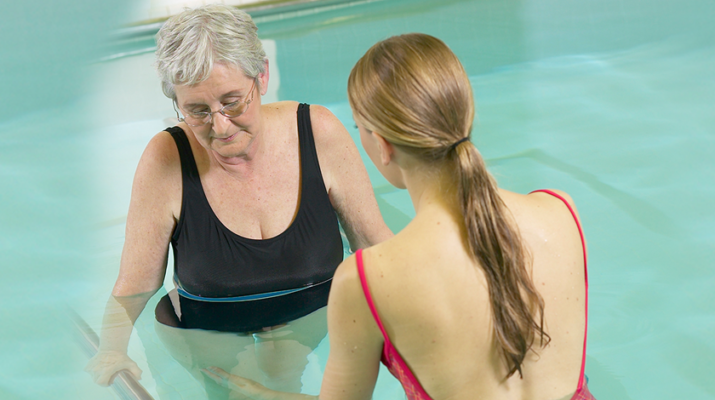By Deborah Jeanne Sergeant
For people recovering from an injury or joint surgery, aquatic therapy may be helpful in getting better sooner.
Like land-based (“dry”) physical therapy, aquatic therapy doesn’t require a physician’s prescription and most insurers cover treatment for a total of 30 days. At that point, a prescription would be required.
“To understand aquatics, you have to understand the hydrodynamics of water,” said Carol Sames, associate professor in department of physical therapy education at Upstate Medical University.

“There’s buoyancy and resistance. As the water gets deeper, you have resistance. You also get buoyancy. At waist-high water, you weigh 50% of your bodyweight. It’s less force on joints. At chest-high, you’re unweighted by 80%.”
Unlike land-based exercise, the pool challenges their posture, balance and core strength. But the water reduces risk of falls.
“Maybe a patient is someone who’s been sedentary and lacks muscle strength to bear weight a long time,” Sames said. “Or someone with a neuro-muscular condition. They’ve started using a cane, crutch or wheelchair for longer distances. They get in the pool and can walk. For individuals with chronic pain from osteoarthritis or rheumatoid arthritis, you have less force on joints. That can be very helpful.”
The water also helps patients who have cerebral palsy, multiple sclerosis or impairment from a stroke if land physical therapy is too challenging.
The 86- to 96-degree F temperature of most therapy pool also helps keep patients comfortable.
“You want to be in warm water for physical therapy,” said Elizabeth Cullen, physical therapist and owner of CNY Physical Therapy & Aquatic Center in Camillus. “You don’t want it too hot, or you’ll have difficulty with cardiovascular movement. If it’s too cold, you’ll start to shiver a little. The joints won’t move as well.”
Most physical therapists use devices in the pool like noodles and flotation boards to help with movement or to encourage patients to stretch further and challenge themselves.
Most therapy pools are relatively shallow, as they’re not meant for diving or swimming laps. Cullen can accommodate people of varying heights with depths of four to five and a half feet. The pool’s smaller size, handrails and nearby walls help keep comfortable clients nervous about being in the water. The pool also features a chair lift for those who cannot manage the stairs.
Kuss Physical and Aquatic Therapy in Central Square offers “prehab” in anticipation of joint replacement surgery to help patients build strength without as much pain.
“It’s a great way to prepare for people waiting for surgery,” said John Kuss, physical therapist and owner of the practice. “They can maximize their strength and mobility. The better off you are going in, the better the outcome of the surgery. In the water, you’re exercising and burning calories. That will benefit people who need to lose weight before surgery. You’re constantly moving in the water without the same stress to the joints.”
“The same goes for people who want to start exercising but feel that traditional exercise is too hard because of chronic joint pain and fear injury,” he added.
Kuss also said that patients with edema—swelling in their legs—often find that the pool’s hydrostatic pressure helps reduce their swelling, even if their purpose of being in the pool is to treat a different area of the body.
Once their round of physical therapy is complete, patients can purchase a gym membership at Kuss to continue improving their health and movement with therapists nearby to assist as needed.
In addition to their training in physical therapy, physical therapists who provide aquatic therapy take continuing education credits to learn how to apply physical therapy principles in the water.
Few conditions contraindicate aquatic physical therapy, such as an open wound or incision. Patients should ask their primary care providers about any concerns.

